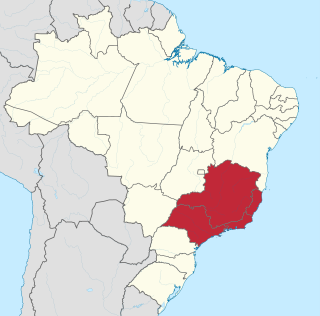
Ouro Preto, formerly Vila Rica, is a Brazilian municipality located in the state of Minas Gerais. The city, a former colonial mining town located in the Serra do Espinhaço mountains, was designated a World Heritage Site by UNESCO due to its Baroque colonial architecture. Ouro Preto used to be the capital of Minas Gerais from 1720 until the foundation of Belo Horizonte in 1897.

The Federal University of Minas Gerais is a federal research university located in the state of Minas Gerais. Its main and biggest campus is located in the city of Belo Horizonte, Brazil. It is one of Brazil's five largest and highest-ranked universities, being the largest federal university. It offers 79 undergraduate education programs, upon completion of their curricular schedule the student is awarded either a bachelor's degree, a licenciate degree, or a professional title, all officialized by the issue of a university diploma. It also has 90 postgraduate education programs, awarding 30 postbaccalaureate specialization degrees, 92 master's degrees, and 72 doctoral degrees, as well as 41 medical residency programs offered at UFMG's hospital facilities complexes.

Diamantina is a Brazilian municipality in the state of Minas Gerais. Its estimated population in 2020 was 47,825 in a total area of 3,870 km2.

The Southeast Region of Brazil is composed of the states of Espírito Santo, Minas Gerais, Rio de Janeiro and São Paulo. It is the richest region of the country, responsible for approximately 60% of the Brazilian GDP, as São Paulo, Rio de Janeiro, and Minas Gerais are the three richest states of Brazil, the top three Brazilian states in terms of GDP. The Southeast of Brazil also has the highest GDP per capita among all Brazilian regions.

João Pinheiro da Silva was a Brazilian lawyer, industrialist and politician who served as president of Minas Gerais. A defender of republicanism during Brazil's Imperial era, Pinheiro became the main republican figure in Minas Gerais, leading the foundation of the Republican Party of Minas Gerais in 1888.

Science and technology in Brazil has entered the international arena in recent decades. The central agency for science and technology in Brazil is the Ministry of Science and Technology, which includes the CNPq and Finep. This ministry also has a direct supervision over the National Institute for Space Research, the National Institute of Amazonian Research, and the National Institute of Technology (Brazil). The ministry is also responsible for the Secretariat for Computer and Automation Policy, which is the successor of the SEI. The Ministry of Science and Technology, which the Sarney government created in March 1985, was headed initially by a person associated with the nationalist ideologies of the past. Although the new minister was able to raise the budget for the science and technology sector, he remained isolated within the government and had no influence on policy making for the economy.
Carl August Wilhelm Schwacke (1848–1904) was a German botanist, explorer and naturalist.
Djalma Guimarães, was a pioneer Brazilian geochemist. He was Professor Emeritus at the Ouro Preto Mining School and at the Federal University of Minas Gerais, in Belo Horizonte. At both institutions, he taught geological sciences for over 35 years.

Faculdade de Direito e Ciências do Estado da Universidade Federal de Minas Gerais is the university's oldest unit, and even appeared before UFMG. Recognized internationally, it is considered a center of excellence in legal education, professional training with great ability and critical view. The qualification of teachers - most have the title of doctor - and the high level of students ensure the recognition of its progress.
Octávio Barbosa was a Brazilian geologist.

The Federal University of São João del-Rei is a Brazilian university in the city of São João del-Rei in the state of Minas Gerais. It has other campuses in the cities of Ouro Branco, Divinópolis and Sete Lagoas, all of them in the state of Minas Gerais.

Afonso Celso de Assis Figueiredo, the Viscount of Ouro Preto was a Brazilian politician, and the last Prime Minister of the Empire of Brazil.
The Federal University of Alfenas is a public institution of undergraduate and postgraduate education situated in Alfenas and having campuses in the cities of Poços de Caldas and Varginha, all in the southern region of the Brazilian state of Minas Gerais.

The Federal Institute of Minas Gerais, or in full: Federal Institute of Education, Science and Technology of Minas Gerais is a polytechnic university or community college located in the Brazilian cities of Belo Horizonte, Bambuí, Congonhas, Formiga, Governador Valadares, Ouro Preto, Ouro Branco, São João Evangelista and João Monlevade.

The Federal University of Triângulo Mineiro is a public university located in the city of Uberaba, Minas Gerais, Brazil, formerly FMTM and transformed into a university in 2005 by a federal government decree.
The Ouro Preto murder case refers to the murder of the student Aline Silveira Soares, found dead in a cemetery in the city of Ouro Preto, Minas Gerais, Brazil. The case triggered significant national coverage by the Brazilian press at the beginning of 2000s.

Dulce Pereira is a Brazilian adjunct professor at the Federal University of Ouro Preto (UFOP). Among other activities she has been the president of the Palmares Cultural Foundation and, as a Brazilian diplomat, president of the Community of Portuguese Language Countries. As of 2024 she was employed by the Brazilian Ministry of Women. Pereira is a long-time member of the Workers' Party.












